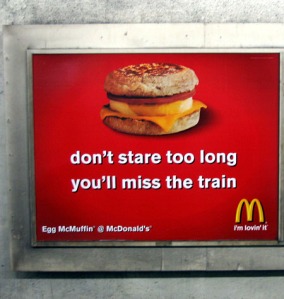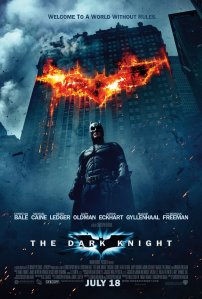I’ve been thinking a lot about the word anchor since reading Ronald Barthes’s “Rhetoric of the Image”. Let me start from the beginning, though.
Before defining the word, anchor, Barthes establishes the probably that “in ever society, various techniques are developed intended to fix the floating chain of signifieds in such a way as to counter the terror of uncertain signs…” In other words, every picture has an infinite scope of contextual potential. So, with such a wide array of possible meanings for a picture—varying by who is looking and when/where they are—pictures need anchors, or something to provide “control” and “bear a responsibility—in the face of projective power of pictures—for the use of the message.”
Take this advertisement for example:

I found this picture online when I searched ‘McDonald’s advertisements’ on Google. Obviously, it is a picture of an advertisement, but we’ll pretend for the moment that we’re seeing it in person.
Imagine there were no text on the advertisement, and just a picture of an Egg McMuffin. Sure, many people would still see it as an advertisement, but it would also lose a lot of potential viewers in the noise surrounding it. These days, don’t pictures of fast food remind us of things like hear disease, obesity epidemics, animal cruelty, and minimum wage concerns as much as they remind us about the food itself? The Egg McMuffin is not innocent, and McDonald’s knows this.
The anchor text of the image reads, “don’t stare too long[,] you’ll miss the train”. Here, McDonald’s is distracting us from the rest of this contextual noise and making us see it as they want to see it: desirable. But I don’t think McDonald’s expects anyone to actually think, Aw man, I almost missed my train because I was so lost in the beauty of this Egg McMuffin! Good call, McDonalds. More likely, McDonald’s wants us to pick up on their intertextual play with sexual phrases. The “don’t stare too long” is just a textual equivalent of the quintessential American scene wherein the gawking male momentarily loses his wits while checking out a woman. Or, in linguistic form, something along the lines of this:

The McMuffin advertisement gets even more interesting once you look at its placement within the frame. We might expect the text to be somewhere on the bottom, in some more marginal position while the image engulfs most of the space. However, the anchor of this advertisement consumes half of the picture, given an equal prominence to the McMuffin itself. Whereas most advertisements idealize their products at the center of the picture, McDonald’s does not. It’s almost as if McDonald’s, through their suggestive language, is acknowledging that it is unhealthy—something less like food and more like a casual encounter with a stranger. And by making the text as prominent as the image, the reader is gestured to consider the guilty proposal as much as we are the product.
After all of this, I’ve come to see anchors as not only holding down a meaning for the picture, but also as attempts by certain parties to anchor the reader/viewer, to try and sway us away from the more prevalent—and perhaps more important—meanings behind objects. We, as consumers and citizens, need to remain critical and skeptical, so as not to fall under the spell of such textual hypnotics.










